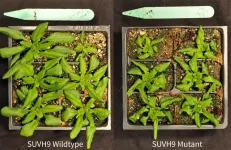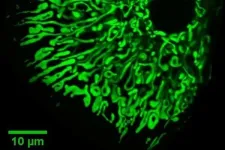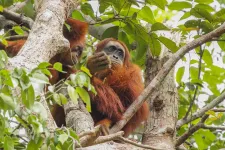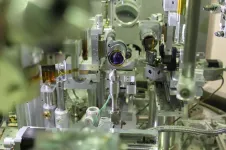Opening up possibilities with open-top optofluidic device
Co-planar optoelectrowetting device allows for droplet access from above that increases microfluidic input/output system integration configurations while achieving faster droplet speeds
2021-05-20
(Press-News.org) Microfluidic technologies have seen great advances over the past few decades in addressing applications such as biochemical analysis, pharmaceutical development, and point-of-care diagnostics. Miniaturization of biochemical operations performed on lab-on-a-chip microfluidic platforms benefit from reduced sample, reagent, and waste volumes, as well as increased parallelization and automation. This allows for more cost-effective operations along with higher throughput and sensitivity for faster and more efficient sample analysis and detection.
Optoelectrowetting (OEW) is a digital optofluidic technology that is based on the principles of light-controlled electrowetting and enables the actuation and manipulation of discrete droplets. OEW devices have many advantages, such as the ability for large-scale, real-time, and reconfigurable control of picoliter- to microliter-sized droplets by adjusting the number and size of low-intensity optical light patterns incident on the device. With each individual droplet on the OEW device acting as its own bioreaction chamber, the OEW device also has the ability to support multiplex capabilities. This can prove to be beneficial in applications such as single-cell analysis and genomics or combinatorial libraries.
Previous traditional OEW devices provide a flexible platform to perform chemical and biological assays such as real-time isothermal polymerase chain reaction with basic droplet manipulation techniques. However, in these OEW devices, droplets are sandwiched between a bottom active OEW substrate and a top layer ground electrode substrate, forcing any input/output fluidic configurations to be integrated from the side openings. Although feasible, this can prove to be limiting for system integration.
Researchers from the University of California, Berkeley, created a single-sided, co-planar OEW device that allows for individualized and parallel droplet actuation and benefits from easier droplet accessibility from above for more input/output configuration schemes. This was achieved by eliminating the need for a top cover electrode found in traditional OEW devices by fabricating a metal mesh grid integrated on the OEW device. Droplets can still move freely around the two-dimensional device surface and are now accessible from above due to the open-top design.
In their research, recently published in SPIE's new Journal of Optical Microsystems, they have also derived a theoretical model of the co-planar OEW device to better understand how the integrated metal mesh grid affects device and droplet performance. Analysis gathered from the co-planar OEW model was used to optimize the co-planar device structure and operation. They have demonstrated the ability for basic droplet manipulation, such as individual droplet operations in parallel, merging of multiple droplets, and the ability to handle and move droplets with varying volumes simultaneously.
The co-planar device improves on the traditional OEW device's droplet actuation performance with speeds more than two times faster, up to 4.5 cm/s. Higher droplet speeds on the co-planar OEW device achieved despite a marginal reduction in effective force compared to the traditional OEW device can be partly attributed to the reduction in friction due to elimination of the top cover.
In addition, the ability to operate co-planar OEW devices with 95% reduced light intensity was demonstrated. To showcase the benefit of having exposed droplets to accommodate a wider range of input/output configurations, a droplet-on-demand dispensing system from above was integrated with the co-planar OEW device to inject, collect, and position individual droplets and form large-scale droplet arrays of up to 20 by 20, covering the whole device surface area. Creating larger OEW devices should allow for even more droplets to be accommodated on chip.
With this research, the team has developed an OEW platform for reliable droplet manipulation that can accomplish most basic biological and chemical benchtop techniques. The co-planar OEW device expands the flexibility and range of possibilities for optofluidic technologies to realize greater system integration capabilities and biological and chemical applications.
INFORMATION:
Read the open-access article by Jodi Loo, Shao Ning Pei, and Ming Wu, "Co-planar light-actuated optoelectrowetting microfluidic device for droplet manipulation," J. Optical Microsystems 1(3), 034001 (2021), doi: 10.1117/1.JOM.1.3.034001.
[Attachments] See images for this press release:
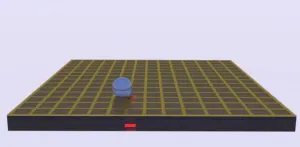
ELSE PRESS RELEASES FROM THIS DATE:
2021-05-20
Since our ancestors infected themselves with retroviruses millions of years ago, we have carried elements of these viruses in our genes - known as human endogenous retroviruses, or HERVs for short. These viral elements have lost their ability to replicate and infect during evolution, but are an integral part of our genetic makeup. In fact, humans possess five times more HERVs in non-coding parts than coding genes. So far, strong focus has been devoted to the correlation of HERVs and the onset or progression of diseases. This is why HERV expression has been studied in samples of pathological origin. Although important, these studies ...
2021-05-20
Passing down a healthy genome is a critical part of creating viable offspring. But what happens when you have harmful modifications in your genome that you don't want to pass down? Baby plants have evolved a method to wipe the slate clean and reinstall only the modifications that they need to grow and develop. Cold Spring Harbor Laboratory (CSHL) Professor & HHMI Investigator Rob Martienssen and his collaborators, Jean-Sébastien Parent and Institut de Recherche pour le Développement Université de Montpellier scientist Daniel Grimanelli, discovered one of the genes responsible for reinstalling modifications in a baby plant's genome.
A plant's genomic modifications--called epigenetic ...
2021-05-20
The study sought to describe and explain gender pay differences in the U.S. Department of Health and Human Services between 2010 and 2018. HHS comprises a quarter of the country's governmental public health workers, with over 80,000 employees.
Understanding what may be driving wage gaps at HHS provides opportunities for employers and legislators to take action to support women in the health care field, said lead author Zhuo "Adam" Chen, an associate professor of health policy and management at UGA's College of Public Health.
"A large percentage of the health care workforce are women," said Chen. "If you have underpaid women in the profession, I don't think it spells good things for the public health system."
Chen ...
2021-05-20
Maywood, Ill. - May 19, 2021 - A team of scientists from Loyola University Chicago's Stritch School of Medicine have discovered a critical component for renewing the heart's molecular motor, which breaks down in heart failure.
Approximately 6.2 million Americans have heart failure, an often fatal condition characterized by the heart's inability to pump enough blood and oxygen throughout the body. This discovery could represent a novel approach to repair the heart.
Their findings, published in the May 19 issue of Nature Communications, show how a protein called BAG3 helps replace "worn-out" components of the cardiac sarcomere. The sarcomere is a microscopic ...
2021-05-20
FINDINGS
A new multi-institution study led by a team of researchers at the David Geffen School of Medicine demonstrated that blocking a protein called ABCB10 in liver cells protects against high blood sugar and fatty liver disease in obese mice. Furthermore, ABCB10 activity prompted insulin resistance in human liver cells.
The findings are the first to show that ABCB10 transports biliverdin out of the mitochondria - the cell's "energy generating powerhouses." Biliverdin is the precursor of bilirubin, a substance with antioxidant properties. Consequently, ABCB10 transport ...
2021-05-20
So, you thought the problem of false information on social media could not be any worse? Allow us to respectfully offer evidence to the contrary.
Not only is misinformation increasing online, but attempting to correct it politely on Twitter can have negative consequences, leading to even less-accurate tweets and more toxicity from the people being corrected, according to a new study co-authored by a group of MIT scholars.
The study was centered around a Twitter field experiment in which a research team offered polite corrections, complete with ...
2021-05-20
Orangutans are closely related to humans. And yet, they are much less sociable than other species of great apes. Previous studies have showed that young orangutans mainly acquire their knowledge and skills from their mothers and other conspecifics. Social learning in orangutans occurs through peering, i.e. sustained observation of other members of the species at close range.
An international team led by the University of Zurich (UZH) has now studied peering behavior in young orangutans at two research stations on the islands of Sumatra and Borneo. The data was collected by researchers from the Department of Anthropology of UZH, the Max Planck Institute of Animal Behavior in Constance, the Universitas Nasional in Jakarta and Leipzig University, ...
2021-05-20
Do we have free choice or are our decisions predetermined? Is physical reality local, or does what we do here and now have an immediate influence on events elsewhere? The answers to these questions are sought by physicists in the Bell inequalities. It turns out that free choice and local realism can be skilfully measured and compared. The results obtained reveal surprising relationships of a fundamental and universal nature, going far beyond quantum mechanics itself.
Causality, locality, and free choice are related by a few simple formulas known as Bell's inequalities. The sophisticated experiments in quantum optics over the past few decades have unquestionably proved that these inequalities are broken. Today, physicists are ...
2021-05-20
The genome is tightly organised (packaged) within the cell nuclei. This three-dimensional (3D) genome organisation is fundamental, given that it regulates gene expression.
A study led by scientists at the Universitat Autònoma de Barcelona (UAB) now demonstrates using mice models that the 3D organisation of the genome is extremely dynamic during the formation of male germ cells (precursors of spermatozoa) and that alterations in this structure can affect fertility.
The research, published in Nature Communications, describes the 3D genome organisation in germ cells of wild populations of house mice (Mus musculus domesticus) with chromosomal rearrangements, ...
2021-05-20
Since they are far more compact than today's accelerators, which can be kilometers long, plasma accelerators are considered as a promising technology for the future. An international research group has now made significant progress in the further development of this approach: With two complementary experiments at the Helmholtz-Zentrum Dresden-Rossendorf (HZDR) and at the Ludwig-Maximilians-Universität Munich (LMU), the team was able to combine two different plasma technologies for the first time and build a novel hybrid accelerator. The concept could advance accelerator development ...
LAST 30 PRESS RELEASES:
[Press-News.org] Opening up possibilities with open-top optofluidic device
Co-planar optoelectrowetting device allows for droplet access from above that increases microfluidic input/output system integration configurations while achieving faster droplet speeds


